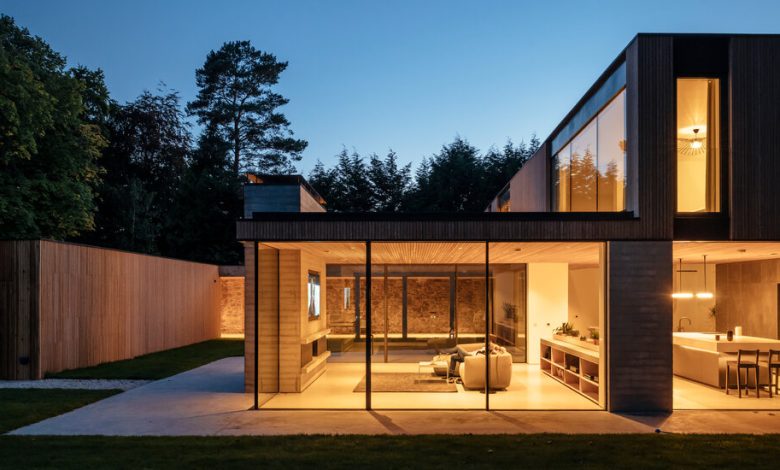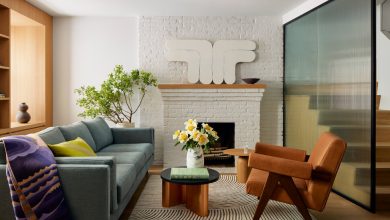In Scotland, a Minimalist House That Keeps the World at Bay

Russel Davies and Wendy Wilkie were ready to start walking.
After raising six children from previous relationships in a five-bedroom converted barn in the countryside outside Aberdeen, Scotland, all the empty rooms and open spaces began to feel superfluous.
“We started thinking about what we wanted to do next,” said Mr. Davies, 64, the chief executive of an oil industry company. For years, he said, “we were essentially taxi drivers for the kids — anything we wanted to do, we had to drive.”
After that, a walkable lifestyle seemed more appealing. So he and Ms. Wilkie, 55, resolved to build a small, modernist house that was entirely their own within striking distance of the center of Aberdeen, a city of about 227,000 people, roughly 130 miles north of Edinburgh.

Russel Davies and Wendy Wilkie worked with Brown & Brown Architects to build a modern home in Aberdeen, Scotland, that reuses parts of an old stone carriage house.Credit…Jim Stephenson
“When we started looking at where we wanted to live, we made a list: We wanted to be in a community; we wanted to be able to walk to a pub on a Friday night; we wanted to be close to a bus route into the city,” Mr. Davies said. “We wanted to be close to shops, so we wouldn’t have to get in the car every time.”
As they began looking for a lot, they engaged Brown & Brown Architects, a firm whose work they had admired on Instagram, to help choose the property and design the house. For a couple of years, they searched for the ideal building site, but the best lots were always too far from the city center.
Finally, in 2019, they heard about a half-acre lot on the outskirts of Aberdeen, with a dilapidated 19th-century stone coach house on it that had been converted into a home. “It had woodworm in all the roof joists, and you could have pushed in the old windows if you had wanted to,” Mr. Davies said. “It was just rotten and damp.”
But when Andrew Brown, who runs Brown & Brown with his wife, Kate Brown, gave his approval, the couple bought it for about 425,000 British pounds (about $525,000), planning to knock down the old house to make way for a new one.
“They were moving from a rural area into the city, which is the opposite of 90 percent of the projects we do,” Mr. Brown said. “Traditionally, people are escaping the city. But this lot is in the west end of Aberdeen, which has nice Victorian buildings and terraced housing. It’s a busy area, but one of the nicer areas, and there are not many opportunities to build a new building in a setting like that.”
As it turned out, the parcel was in a conservation zone, so even if the old stone building was falling apart, they couldn’t tear it down. “In general, Historic Environment Scotland doesn’t want to see any buildings demolished — even if they are crumbling and falling down, which was the case here,” Mr. Brown said.
The architects proposed a compromise: They would preserve the stone wall from the old home that was closest to the busy road and incorporate it into the new house. Then they would use the stone from the building’s other walls to clad a new garage and build a boundary wall by the sidewalk, which is common in the area. After nearly a year and a half of negotiation, city planning authorities approved the idea.
Brown & Brown placed the garage at the front of the lot. From there, a covered outdoor colonnade with the old stone wall on one side leads to the front door of the new 2,950-square-foot house. That passageway is “like an airlock” that keeps the outside world at bay, Mr. Brown explained. “We’re trying to separate the house from everyday life a little bit.”
The house itself comprises two boxes made of glass, concrete and larch-wood slats, stacked perpendicularly and topped by green roofs. On the ground floor, a kitchen with cabinets finished in composite slate fronts and a long island with a cantilevered microcement top is open to a glass-walled living room. A double-height dining area is dominated by a sculptural spiral staircase that Angus & Mack, a woodworking company, constructed from overlapping layers of birch plywood.
Upstairs, the smaller second level contains the primary suite, a guest room and a home gym. Built by the contractor Coldwells Build, the house took roughly a year and a half to complete, at a cost of about £1.2 million ($1.48 million). Mr. Davies and Ms. Wilkie moved in last July.
Most of the windows in the home are positioned to offer views into the back garden or out across the green roofs, which sprout with grasses and wildflowers, and are “extensions of the garden,” Mr. Brown said. “We wanted to create spaces that felt like they were in a garden rather than next to a garden.”
The effect makes for “a really peaceful house,” Ms. Wilkie said, especially because the stone walls protect the house from the road, creating visual and auditory privacy.
“Because of the way Andrew designed it, with the enclosed garden and the colonnade, nobody can see in, nobody can hear us, and we can’t hear them,” Mr. Davies said. “When you sit in the lounge and look out the windows, all you see are the trees.”
The house, they agreed, captures the best aspects of rural and urban living.
“You still have that feeling of living in the countryside,” Mr. Davies said. “But you walk out the door and you’re two minutes from a bus stop and five minutes from the pub. It’s everything we wanted.”
For weekly email updates on residential real estate news, sign up here.



